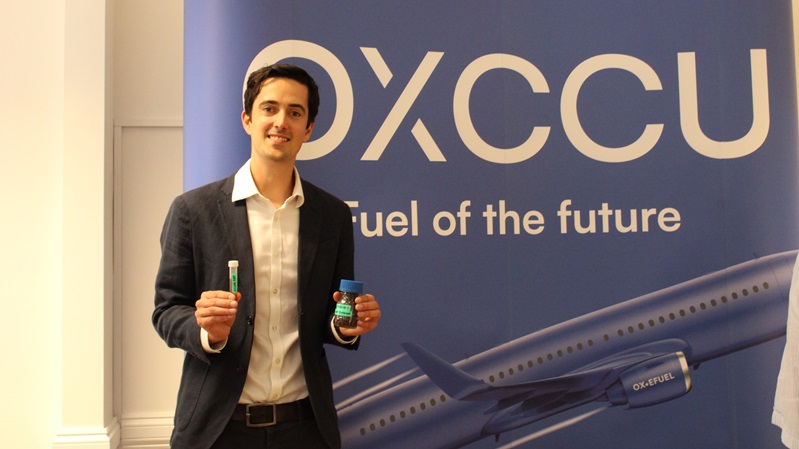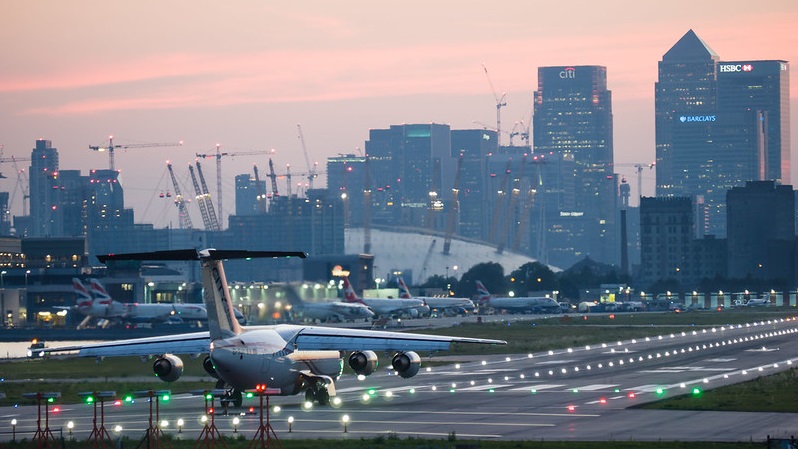This week, the UK’s new centre-left government approved an expansion of London City Airport, which would allow the business travel hub to fly an extra 2.5 million passengers a year.
Monday’s approval follows similar green lights for airport expansion given by the previous centre-right government – and goes against the firm advice of the UK’s official climate change advisory body, as well as opposition from climate campaigners and East Londoners concerned about noise and carbon pollution.
The Climate Change Committee said last June that “there should be no net airport expansion across the UK” and “no airport expansions should proceed until a UK-wide capacity management framework is in place”. A spokesperson told Climate Home this remains the committee’s position.
But, approving the London City expansion, Labour ministers Angela Rayner and Louise Haigh said in a statement that the lifting of the cap from 6.5 million to 9 million passengers a year would bring more jobs and tourists to London and boost business productivity. They added that the expansion would not conflict with the government’s “Jet Zero Strategy” – to clean up aviation – nor prevent the UK from meeting its 2050 net zero target because the additional emissions would not be significant.
Sign up to get our weekly newsletter straight to your inbox, plus breaking news, investigations and extra bulletins from key events
Climate campaigners said the move highlights the flaws of the UK’s airport planning policy and its Jet Zero Strategy, which aims to cut emissions from aviation with cleaner fuels, carbon offsets and carbon dioxide (CO2) removal machines while passenger numbers increase by about half between 2018 and 2050.
Other bigger London airports – including Heathrow, Gatwick, Luton and Stansted – are also considering expansion or seeking permission to expand.
For the London City decision, ministers relied heavily on advice from two planning inspectors, Claire Searson and Johanna Ayres. The inspectors concluded that, according to the Jet Zero Strategy, the emissions from airport expansions can be “accommodated within the planned trajectory for achieving net zero emissions by 2050” and therefore “our planning policy frameworks remain compatible with the UK’s climate change obligations”.
The Jet Zero Strategy was published by the last Conservative government in July 2022. It aims to reach net zero in the aviation sector by 2050 – a goal it says is “hugely challenging”.
In a world first, Grenada activates debt pause after Hurricane Beryl destruction
Alethia Warrington, a climate campaigner at an NGO called Possible, told Climate Home the UK was “ahead of the curve” compared to other countries in setting this target but that its projections for passenger growth were “incredibly dangerous”. Possible is challenging the strategy in court. Greenpeace campaigner Paul Morozzo said the strategy was built on “false hope”.
The plan does not include any measures to limit the number of flights or the capacity of airports, allowing planning inspectors and ministers to conclude that airport expansions are not counter to the strategy.
Instead, it plans to achieve just under half of the sector’s emissions reductions – excluding abatement measures it defines as outside the aviation sector, like carbon removal technology – by buying carbon offsets. But many carbon offsets, where the buyer pays someone else to reduce emissions on their behalf, have been found not to deliver the emissions savings they claim.
The Jet Zero Strategy plans to get about a quarter of the emissions cuts it defines as coming from within the sector through fuel efficiency improvements, another quarter from “sustainable aviation fuels” (SAFs) and a small amount from zero-emission aircraft.
Many airlines are buying more fuel-efficient aircraft, shaving a chunk off their planet-heating pollution. But the viability and sustainability of SAFs has been challenged by campaigners, regulators and even airline executives.
Currently, the only non-fossil fuel commercially available for planes is made from biomass, turning crops like corn, soy and oil palm, or used cooking oil, into jet fuel.
But there is nowhere near enough of this being produced to meet demand. Ryanair CEO Michael O’Leary said in December “there isn’t enough cooking oil in the world to power more than one day’s aviation”. As a result, SAF is currently more than four times as expensive as regular oil-based jet fuel.
Biofuels also often compete with food crops, worsening hunger and encouraging deforestation. The UK’s advertising regulator recently ruled that airline Virgin Atlantic should not have told customers it flew a plane on “100% sustainable aviation fuel” because it gave the misleading impression that the fuel was entirely green.
Subject to parliamentary approval, the UK is planning to implement a SAF mandate to start from January 2025, at 2% of total UK jet fuel demand, increasing to 10% in 2030 and then to 22% in 2040. It will also introduce a bill that offers revenue support for SAF producers looking to invest in new plants in the UK.
Andrew Symes is the CEO of a company called OXCCU which has just started producing tiny test quantities of SAF in a container next to Oxford Airport in England. Earlier this month, he told journalists visiting the site that SAFs based on biofuel alone would not be sufficient, so his company is developing a SAF that mixes carbon dioxide and green hydrogen.

OXCCU CEO Andrew Symes holds up his company’s catalyst and SAF at its new test plant in Oxford (Photo: OXCCU)
But Symes acknowledged that the fuel is “not perfect”, as the CO2 will be bought from industry – and burning it will damage the planet. But, he said, it still offers a “huge emission saving” compared to conventional jet fuel, and could be made carbon neutral by capturing the emitted CO2 from the atmosphere.
Producing it in this carbon-neutral way, however, would require huge numbers of CO2 removal machines, as well as solar panels and wind turbines to produce the renewable electricity needed to make green hydrogen, he noted.
He predicted this kind of fuel would be used in planes in small quantities towards the end of the decade and could be scaled up from there. But Possible’s Warrington disputed that assertion.
“The idea that we can magic up this gigantic renewable capacity to produce e-fuel so a small group of wealthy frequent flyers never have to take the train – it’s just not doable,” she said. Warrington predicted it would be a “fairly sizable number of decades” before zero-carbon flights are common.
Even if all the emissions reduction measures outlined in the UK Jet Zero Strategy’s high-ambition scenario are successful, it still envisions aviation producing 19 million tonnes of CO2 equivalent a year in 2050 – about half the current level.
It plans to address these left-over emissions through CO2 removals, but Warrington is sceptical. “There’s no payment mechanism for this. It would be horrendously expensive. It would be extremely resource-intensive,” she said. “It just doesn’t stack up at all.”
A spokesperson for the Department of Transport told Climate Home the government was dedicated to securing the long-term future of the UK aviation industry, while making Britain “a clean energy superpower” – and would work closely with the sector to achieve those aims.
(Reporting by Joe Lo; editing by Megan Rowling)
This article was updated after publication to add comment from the Department of Transport and to clarify the share of emissions reductions to be provided by different methods under the Jet Zero Strategy.
